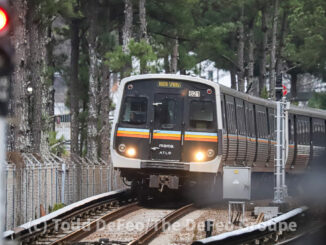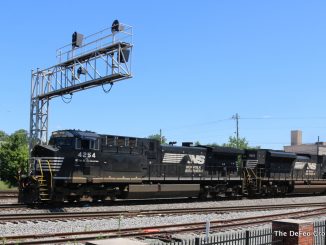Like any other year, 2006 saw its fair share of ups and downs for the railroad industry.
Some stories were hard to list in a particular month. The controversy over the Duluth, Minnesota & Eastern Railroad’s federal loan is a good example, and could probably make a good argument for “Story of the Year.”
Because of the difficulty, DM&E-related entries might not be found in every month, but its importance as a story in 2006 is not overlooked.
While it is impossible to list every story that impacted the railroad world in 2006, here is a rundown of some of the top rail- road headlines for 2006:
January 2006
CSX resumes local freight service on its Gulf Coast Line, a vital transportation artery to New Orleans. The line was shut down following Hurricane Katrina.
A passenger train carrying at least 250 people, many of whom were children, derailed in Serbia-Montenegro and crashed into a ravine. Nearly 200 people were injured and 44 were killed in the wreck. Most of the passengers were schoolchildren returning from a ski trip.
February 2006
William Thomas Rice, a decorated soldier and railroad visionary who was instrumental in the 1980 creation of CSX Corp., died in Richmond, Va., on Feb. 5 after a brief illness. He was 93.
Rice, chairman emeritus of Seaboard Coast Line Industries Inc., a predecessor company of CSX Corp., began his railroad career in 1934 with the Pennsylvania Railroad. He rose from track supervisor to lead railroads that today are part of CSX Transportation Inc.
March 2006
The federal government announced it was testing new safety devices for commuter trains that are designed to better protect passengers during crashes. The systems include crush zones that absorb the force of a crash to better protect the parts of trains where passengers seating areas and operators’ spaces. The crush zones have stronger end frames that act as bumpers to distribute crash forces throughout an entire train so passengers feel less of the impact.
With a nod to its 175-year history, Norfolk Southern Corporation saluted its most successful year ever in its Annual Report.
At Belle Plaine, Kan., BNSF Railway Company announces a major safety milestone, the closure of its 3,000th grade crossing.
Rail service between Iran and Pakistan was suspended after five rocket attacks against the rail line during a 10-day period. Trains had been running between Zahedan, Iran, and Quetta, Pakistan. The bi-weekly passenger service and the weekly freight service was the only rail service between the two counties, according to The Associated Press.
April 2006
Thomas P. Schmidt of Jacksonville, Fla., a 35-year railroad veteran, is appointed to head Amtrak’s Transportation Department.
After a 60-year absence, trolleys rolled once again on downtown Cleveland streets, offering a way to experience the city’s past. Beginning April 10, office workers and tourists were able to hop on one of two trolley lines developed by RTA to replace Loop bus service.
May 2006
From Washington D.C. to New York City, trains powered by overhead electric lines stalled for more than two hours May 25 due to what Amtrak called a “major power outage.”
June 2006
A comprehensive federal study of accident data found that push-pull passenger rail service has an excellent safety record and that a train being pushed has virtually no greater likelihood of derailing after a high- way-rail grade crossing collision than one with a locomotive in the lead, the Federal Railroad Administration said.
Union Pacific introduced the latest addition to its Heritage Series of locomotives – the Denver & Rio Grande Western locomotive. Incorporating historic colors and graphic elements of the Denver & Rio Grande Western Railroad, the new loco- motive pays tribute to the men and women of the railroad that “went everywhere the hard way.”
July 2006
Seven bombs exploded at various railway stations in Bombay on July 11. An alleged member of the Kashmiri militant group Lashkar-e-Toiba was arrested by Indian police in connection with the July 11 train bombings in Bombay which killed 200 commuters on the city’s commuter rail net- work.
The first trains operated over the Qinghai- Tibet Railway line, the world’s highest line. The road, connecting the Tibetan capital Lhasa with Golmud in Qinghai, China, is quite controversial. At its highest point in the Tanggula Pass, the railway line reaches an altitude of 16,640 feet. Because of the height, the train’s cabins are sup- plied with oxygen and the windows have ultra-violet filters to keep out the sun’s glare. The line is not without controversy, though. Critics claim that the railway will be used to assert control over Tibet as the line can quickly transport Chinese troops to Tibet during unrest.
Atlanta’s mass transit system posted its first operating profit in nine years. For fiscal year 2005-06, MARTA finished in the black by $19 million, The Associated Press reported. Officials has expected an $18 million loss.
August 2006
News of a disrupted terror plot quickly translated to increased security measures at rail systems nationwide.
Calling it the most significant development in railroad brake technology since the 1870s, Federal Railroad Administrator Joseph H. Boardman said he was proposing revised federal rail safety regulations to facilitate the installation of Electronically Controlled Pneumatic (ECP) brake systems capable of preventing derailments and shortening train-stopping distances.
The U.S. Surface Transportation Board approved Dakota, Minnesota & Eastern’s application to utilize a separate subsidiary to build and operate a new 280-mile rail line into the Powder River Basin.
Commuter rail in Florida is one step closer to reality, as Gov. Jeb Bush has announced a comprehensive plan aimed at improving freight service and bringing commuter rail to Central Florida. Under the agreement in principle between the Florida Department of Transportation (FDOT) and CSX Transportation Inc. (CSXT), Florida will invest $491 million to improve infrastructure and expand capacity on two existing rail lines, one of which will be used to establish commuter rail service through a multi-county stretch in the region.
New Delhi authorities hoped a fierce looking primate — a langur — would solve the problem of mischievous monkeys infiltrating the city’s subway system. Langurs were brought in to scare away their smaller cousins.
September 2006
A Transrapid maglev train traveling on the system’s test track in Lathen near the Netherlands border in Germany collided with a maintenance vehicle on the track, killing 23 people and severely injuring 10. The driverless train was estimated as operating at above 120 mph when the crash occurred. The unmanned train with 31 passengers aboard crashed into a maintenance wagon containing 2 workers.
The collision of a freight train and a passenger train just north of Cairo in the town of Shebin al-Qanater left five dead and injured another 30.
October 2006
Potentially serious train derailments might be averted as a result of a new federal regulation designed to improve how rail- roads conduct safety inspections of the joints that connect sections of track made of continuous welded rail (CWR), the Federal Railroad Administration said. Unlike conventional track that has short sections of rail bolted together, CWR consists of long ribbons of rail that may extend for a mile or more between joints. Inspections of CWR joints are expected to increase by at least 11 percent per year as a result of the rule. Under the new regulation, for most areas where CWR is used, railroads are required to inspect CWR joints at specified intervals up to four times a year based upon track speeds, the amount of train traffic on the line, and whether passenger trains operate over the tracks.
Gov. Mitt Romney earlier this month directed the MBTA to re-institute regular random bag inspections on the public transit system in order to shake up normal routines and make it more difficult to plan and carry out a potential terrorist act. The MBTA conducted random bag searches for a limited time before and during the Democratic National Convention in 2004.
A successful rail police pilot in the West- ern Cape, South Africa, was implemented nationwide. South African Transport Minister Joseph Radebe said the program, which reportedly resulted in a 68 percent overall decline in crime on trains and in railway stations, was to be implemented throughout South Africa by 2008. More than 5,000 officers will be deployed in rail- way stations and on trains.
BNSF and CSX announce plans to create a high-volume rail corridor for reliable inter- modal services on the lines connecting California, Atlanta and the rest of the fast- growing Southeast Region.
Passenger and commuter rail cars will be required to have more emergency safety features, including additional window ex- its, under proposed regulations announced by Federal Railroad Administrator Joseph H. Boardman.
November 2006
Six people were killed Nov. 20, and more than 80 people were injured when a bomb exploded on a passenger train near Belacoba, India, a station located about 345 miles north of Calcutta. Authorities suspect terrorists planted a bomb in one of the train’s cars.
Amtrak announced passenger ticket revenue increased in Fiscal Year 2006 to $1.37 billion, the highest annual ticket revenue ever achieved, and, at $132 million over last year, the railroad’s largest year-over- year increase. The railroad also served 24.3 million passengers — nearly 300,000 more than for the same trains in the previous fiscal year.
The French postal service La Poste reached agreement with SNCF, the national rail company, to create a joint rail-based high-speed courier service.
December 2006
As part of an ongoing effort to target the highest risks and major causes of train accidents, the Federal Railroad Administration (FRA) is releasing a study which provides a strong scientific rationale for evaluating railroad employee work schedules to address worker fatigue.
Human factor errors are responsible for nearly 40 percent of all train accidents over the past five years. An FRA evaluation of the research findings confirms that fatigue plays a role in approximately one out of four of those accidents.
The Department of Homeland Security proposed new rules it said would vastly strengthen the security of the nation’s rail systems in the highest threat urban areas.
The Federal Railroad Administration says it wants to increase civil penalties assessed against railroads for violating numerous federal rail safety regulations.
After months of extensive testing, N.J. Transit placed the first multilevel train into service for customers on the Northeast Corridor between Trenton, N.J., and New York.
— Compiled by Todd DeFeo, with Wikinews and Railfanning.org News Wire.




